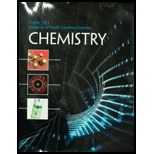
Concept explainers
Calculate the concentrations of all species in a
Interpretation:
The concentrations of all the species present in the solution, which contains phosphoric acid, is to be determined.
Concept introduction:
The first ionization of the polyprotic acid takes place as
The second ionization of the polyprotic acid takes place as
The third ionization of the polyprotic acid takes place as
Percent ionization is the percentage of acid that gets dissociated upon addition to water. It depends on the hydronium ion concentration.
Here,
Answer to Problem 148AP
Solution:
Explanation of Solution
Given information:
The concentration of phosphoric acid
Refer to Table
When phosphoric acid is dissolved in water, the dissociation takes place in three steps, as it is a triprotic acid. First, one proton is partially dissociated, since phosphoric acid is a weak acid. Thus, the pH of the solution is determined by the contribution made by all the three proton dissociation steps.
The reaction of the first proton dissociation of phosphoric acid is depicted as
Prepare an equilibrium table and represent each of the species in terms of
Now, substitute these concentrations in equation (1) as
Since the value of
Thus,
Calculate the percent dissociation from equation (4) as
Since the percent dissociation is more than
Since concentration cannot be negative,
Thus,
Also,
Now, the reaction of the second proton dissociation of phosphoric acid is depicted as
Prepare an equilibrium table and represent each of the species in terms of
Now, substitute these concentrations in equation (2) as
Since the value of
Thus,
Also,
Calculate the percent dissociation from equation (4) as
Since the percent dissociation is significantly less than
Now, the reaction of the third proton dissociation of phosphoric acid is depicted as
Prepare an equilibrium table and represent each of the species in terms of
Now, substitute these concentrations in equation (3) as
Since the value of
Thus,
Calculate the percent dissociation from equation (4) as
Since the percent dissociation is significantly less than
Also,
And,
Also,
Therefore, the concentration of all the species in the phosphoric acid solution are as follows:
Therefore, the concentration of all the species in the phosphoric acid solution are as follows:
Want to see more full solutions like this?
Chapter 16 Solutions
CHEMISTRY >CUSTOM<
- 7.5 1.93 2.05 C B A 4 3 5 The Joh. 9 7 8 1 2 7.5 7.0 6.5 6.0 5.5 5.0 4.5 4.0 3.5 3.0 2.5 2.0 1.5 1.0 ppm 9 7 8 0.86 OH 10 4 3 5 1 2 7.5 7.0 6.5 6.0 5.5 5.0 4.5 4.0 3.5 3.0 2.5 2.0 1.5 1.0 ppm 9 7 8 CI 4 3 5 1 2 7.0 6.5 6.0 5.5 5.0 4.5 4.0 3.5 3.0 2.5 2.0 2.21 4.00 1.5 2.00 2.07 1.0 ppm 2.76arrow_forwardAssign the functional group bands on the IR spectra.arrow_forwardFind the pH of a 0.120 M solution of HNO2. Find the pH ignoring activity effects (i.e., the normal way). Find the pH in a solution of 0.050 M NaCl, including activityarrow_forward
- Please help me answer these three questions. Required info should be in data table.arrow_forwardDraw the major organic substitution product or products for (2R,3S)-2-bromo-3-methylpentane reacting with the given nucleophile. Clearly drawn the stereochemistry, including a wedged bond, a dashed bond and two in-plane bonds at each stereogenic center. Omit any byproducts. Bri CH3CH2O- (conc.) Draw the major organic product or products.arrow_forwardTartaric acid (C4H6O6) is a diprotic weak acid. A sample of 875 mg tartaric acid are dissolved in 100 mL water and titrated with 0.994 M NaOH. How many mL of NaOH are needed to reach the first equivalence point? How many mL of NaOH are needed to reach the second equivalence point?arrow_forward
- Including activity, calculate the solubility of Pb(IO3)2 in a matrix of 0.020 M Mg(NO3)2.arrow_forwardIncluding activity coefficients, find [Hg22+] in saturated Hg2Br2 in 0.00100 M KBr.arrow_forwardIncluding activity, calculate the pH of a 0.010 M HCl solution with an ionic strength of 0.10 M.arrow_forward
- Can I please get the graph 1: Concentration vs. Density?arrow_forwardOrder the following series of compounds from highest to lowest reactivity to electrophilic aromatic substitution, explaining your answer: 2-nitrophenol, p-Toluidine, N-(4-methylphenyl)acetamide, 4-methylbenzonitrile, 4-(trifluoromethyl)benzonitrile.arrow_forwardOrdene la siguiente serie de compuestos de mayor a menor reactividad a la sustitución aromática electrofílica, explicando su respuesta: ácido bencenosulfónico, fluorobenceno, etilbenceno, clorobenceno, terc-butilbenceno, acetofenona.arrow_forward
 Chemistry: Principles and PracticeChemistryISBN:9780534420123Author:Daniel L. Reger, Scott R. Goode, David W. Ball, Edward MercerPublisher:Cengage Learning
Chemistry: Principles and PracticeChemistryISBN:9780534420123Author:Daniel L. Reger, Scott R. Goode, David W. Ball, Edward MercerPublisher:Cengage Learning Chemistry: Principles and ReactionsChemistryISBN:9781305079373Author:William L. Masterton, Cecile N. HurleyPublisher:Cengage Learning
Chemistry: Principles and ReactionsChemistryISBN:9781305079373Author:William L. Masterton, Cecile N. HurleyPublisher:Cengage Learning Introductory Chemistry: A FoundationChemistryISBN:9781285199030Author:Steven S. Zumdahl, Donald J. DeCostePublisher:Cengage Learning
Introductory Chemistry: A FoundationChemistryISBN:9781285199030Author:Steven S. Zumdahl, Donald J. DeCostePublisher:Cengage Learning Chemistry & Chemical ReactivityChemistryISBN:9781337399074Author:John C. Kotz, Paul M. Treichel, John Townsend, David TreichelPublisher:Cengage Learning
Chemistry & Chemical ReactivityChemistryISBN:9781337399074Author:John C. Kotz, Paul M. Treichel, John Townsend, David TreichelPublisher:Cengage Learning Chemistry & Chemical ReactivityChemistryISBN:9781133949640Author:John C. Kotz, Paul M. Treichel, John Townsend, David TreichelPublisher:Cengage Learning
Chemistry & Chemical ReactivityChemistryISBN:9781133949640Author:John C. Kotz, Paul M. Treichel, John Townsend, David TreichelPublisher:Cengage Learning General, Organic, and Biological ChemistryChemistryISBN:9781285853918Author:H. Stephen StokerPublisher:Cengage Learning
General, Organic, and Biological ChemistryChemistryISBN:9781285853918Author:H. Stephen StokerPublisher:Cengage Learning





